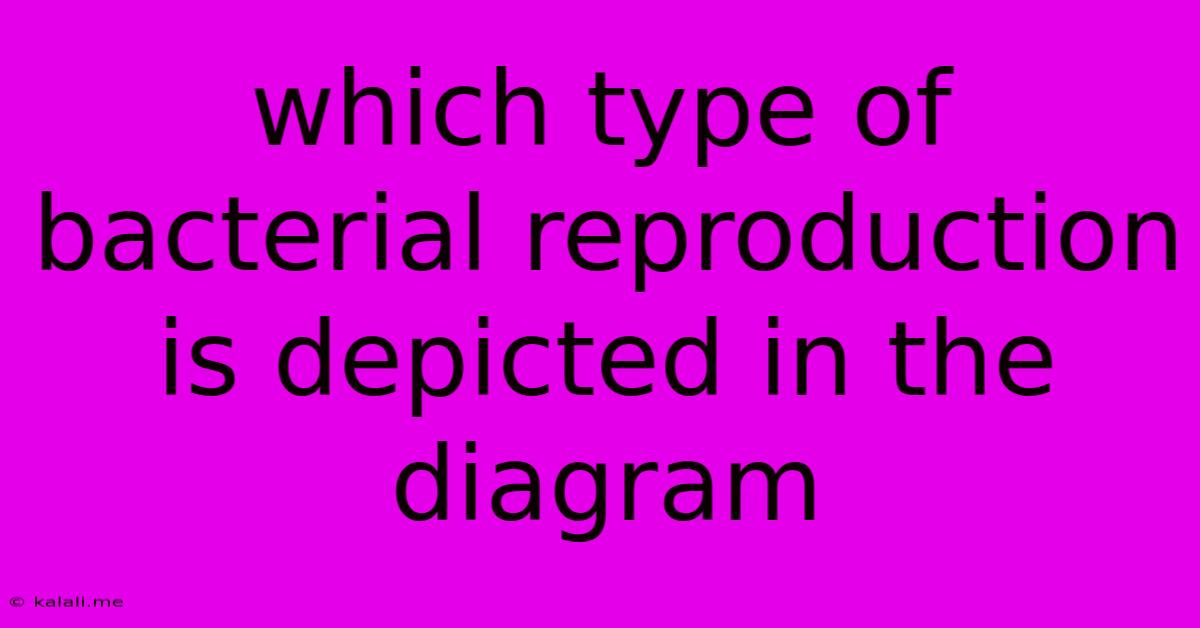Which Type Of Bacterial Reproduction Is Depicted In The Diagram
Kalali
May 10, 2025 · 2 min read

Table of Contents
Which Type of Bacterial Reproduction is Depicted in the Diagram? Understanding Binary Fission
This article will explore the common method of bacterial reproduction, focusing on how to identify it from a diagram. We'll delve into the process of binary fission, clarifying its characteristics and differentiating it from other reproductive strategies. Understanding bacterial reproduction is crucial in various fields, including microbiology, medicine, and environmental science.
What is Binary Fission?
Binary fission is the most common form of asexual reproduction in bacteria. It's a relatively simple process where a single parent cell divides into two identical daughter cells. This process is crucial for bacterial growth and proliferation, enabling rapid colonization in suitable environments. Think of it as a perfect copy – each new cell is genetically identical to the original, barring rare mutations.
Identifying Binary Fission in a Diagram:
To identify binary fission in a diagram, look for these key features:
- Single Parent Cell: The process begins with a single bacterial cell. This cell will contain a single circular chromosome.
- DNA Replication: The first step involves the replication of the bacterial chromosome. The DNA duplicates, creating two identical copies.
- Chromosome Separation: The two replicated chromosomes move towards opposite ends of the cell. This separation is facilitated by various cellular mechanisms.
- Cell Elongation: As the chromosomes separate, the cell begins to elongate, increasing its size to accommodate the two daughter cells. This elongation ensures there's sufficient space for the new cells to form.
- Septum Formation: A septum, or a dividing wall, forms in the middle of the elongated cell, separating the two replicated chromosomes. This septum is a critical structure for the final division.
- Cell Division: Finally, the septum completes its formation, dividing the parent cell into two genetically identical daughter cells. These new cells are now independent and capable of further reproduction via binary fission.
Differentiating Binary Fission from Other Reproductive Mechanisms:
While binary fission is the primary method of bacterial reproduction, some bacteria might exhibit variations or utilize other mechanisms under specific conditions. However, these are less common and typically involve genetic exchange:
- Transformation: Bacteria acquire genetic material from their surroundings.
- Transduction: Genetic material is transferred via bacteriophages (viruses that infect bacteria).
- Conjugation: Genetic material is exchanged directly between two bacterial cells.
These processes are significantly more complex than binary fission and involve genetic recombination, resulting in offspring that are not identical clones of the parent. In contrast, binary fission produces genetically identical offspring, barring spontaneous mutations.
Conclusion:
By carefully examining a diagram for the sequential steps outlined above – DNA replication, chromosome separation, cell elongation, septum formation, and cell division – you can confidently identify the depicted bacterial reproduction as binary fission. Understanding this fundamental process provides valuable insight into the remarkable adaptability and prolific nature of bacteria. Recognizing the characteristic features of binary fission distinguishes it from other, less common reproductive mechanisms in bacteria.
Latest Posts
Latest Posts
-
How Many Numbers Are Between 48 To 24
Jul 02, 2025
-
How Many Positions Are There In Sex
Jul 02, 2025
-
How Many Minutes Are In 10 Miles
Jul 02, 2025
-
How Many Milliseconds Are In A Day
Jul 02, 2025
-
If Your 16 What Year Were You Born
Jul 02, 2025
Related Post
Thank you for visiting our website which covers about Which Type Of Bacterial Reproduction Is Depicted In The Diagram . We hope the information provided has been useful to you. Feel free to contact us if you have any questions or need further assistance. See you next time and don't miss to bookmark.